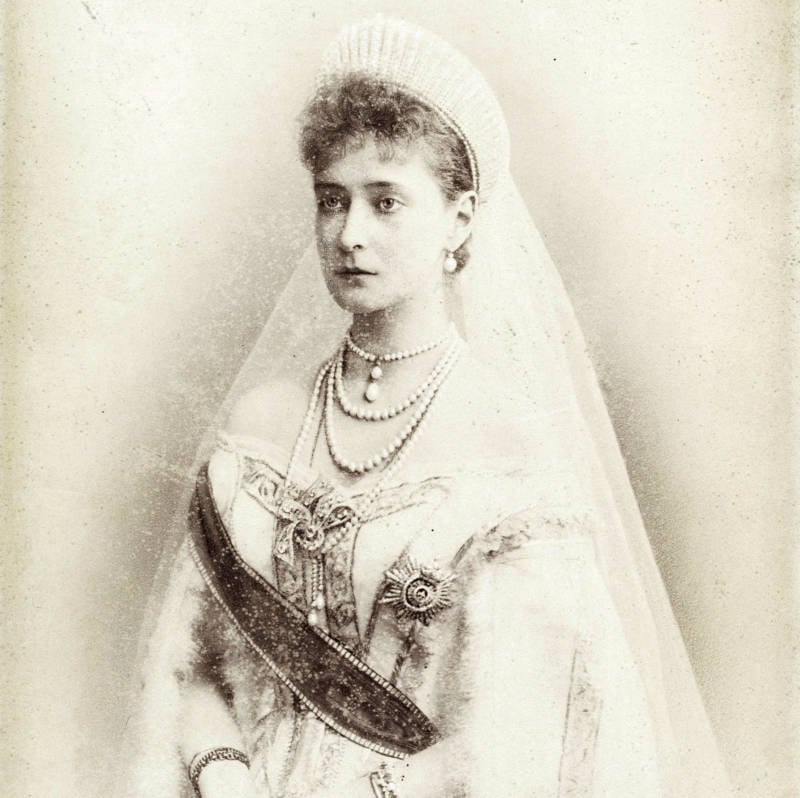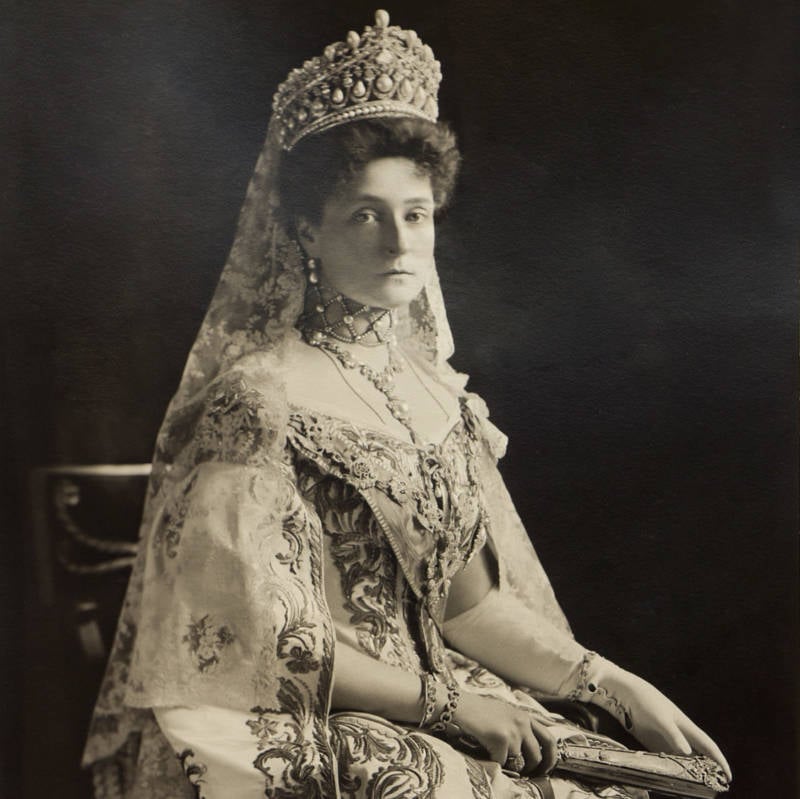Though born and wedded royal, the life of Tsarina Alexandra proved to be anything but charmed.
Alexandra Feodorovna was born Princess Victoria Alix Helena Louise Beatrice in Darmstadt, Germany, on June 6, 1872. Her royal ties to England’s Queen Victoria as her granddaughter gave her clout in Europe and she enjoyed all the trappings of a charmed life.
Unfortunately, her life would become inextricably tied to the future of the Russian government and nation at large. An outsider on the throne of the country of her husband, Tsar Nicholas II, led to her demise and a country-wide revolution.
The Early Life Of Alexandra Feodorovna
The princess’s early life was at once privileged and unstable. While engaged in royal lessons, the sixth child of Grand Duke Louis IV and Princess Alice of the United Kingdom, Alexandra lost her mother when she was six years old.
After that, she spent most of her time with cousins in England. Further, it was suspected that Princess Alix carried the gene for the blood disorder, hemophilia, which she then would pass on to her children.
At age 12, Princess Alix met Grand Duke Nicholas Romanov, heir to the Romanov dynasty in Russia. The two developed a friendship, and later a relationship, which seemed reminiscent of Romeo and Juliet. Princess Alix’s German family preached disdain for Russia, while Nicholas’s father, Tsar Alexander III, didn’t hide his enmity towards Germany.
Regardless, Princess Alix and Grand Duke Nicholas fell in love.
Marriage And A New Life In Tsarist Russia

Empress Alexandra Feodorovna in 1906.
On November 26, 1894, the two married. As she was indoctrinated into the Russian Orthodox Church, Princess Alix took on a new name, Alexandra Feodorovna, and left her old life behind. The occasion of her wedding was sad, though. Nicholas’s father had just died of kidney failure at age 49.
In the empress’s own words, her wedding felt like “a mere continuation of the masses for the dead.”
Although they were in love, they were young. They had lost a guide, Nicholas’ father, Alexander III. Tsar Nicholas II was just 26 when he ascended the throne. He consequently wasn’t ready to take responsibility for Europe’s largest country, which was also filled with ongoing unrest.

Empress Alexandra in her wedding dress, 1894.
Alexandra Feodorovna was only 22 and she had no clue how to run affairs of state. Nicholas came to power when peasants were poor and half of the country’s 150 million residents were considered ethnic minorities. The two certainly had their work cut out for them.
Even though they were married in 1894, the couple’s coronation as leaders didn’t occur until 1896. The coronation of the new Tsar and his wife boded ill for their reign. The day started out cheery enough. The princess wore an opulent dress filled with diamonds and pearls.

romanovempire.org Empress Alexandra in her opulent coronation dress, encrusted with diamonds and pearls, circa 1896.
The feast that celebrated the coronation was set up at Khodynka Field about five miles outside of Moscow. As people sat down to enjoy the dinner, the field collapsed because it was covered with ditches and trenches left over from military drills. A total of 1,300 people died.
The night after the tragedy, rather than visit hospitals where the victims from her wedding recovered, Alexandra Feodorovna and her husband attended a party at the French embassy. Less than a week after the tragedy, Nicholas II held a massive military review on the same field where so many commoners died.
An already ruffled constituency grew ever more impatient with the Romanov royal family.
Rasputin Charmes Alexandra Feodorovna And Russian Royalty
Alexandra Feodorovna also was not popular among Nicholas II’s court. Rather than socialize, she turned towards mysticism and introspection to solve her loneliness. In 1904, after bearing Nicholas four daughters, the consort finally gave birth to a son, Alexei.
Unfortunately, he inherited his mother’s hemophilia and was a sickly young boy.

Wikimedia CommonsRasputin, the monk who had the ear of Empress Alexandra.
Enter Rasputin, the notorious monk and mystic. He supposedly cured young Alexei’s hemophilia when the toddler was three years old in 1908. He became the queen’s confidante and adviser, even though most of Russia (and the royal court) shunned Rasputin’s brand of fanatical mysticism.
In a few short years after Alexei’s cure, Russia faced a new set of problems.
World War I And Russian Revolution
In 1914, Russia went to war with Germany in World War I. Determined to see a Russian victory in the war, Tsar Nicholas II went to the front to command the troops himself in August 1915, although his advisers told him not to.
That left Alexandra Feodorovna in charge of domestic affairs.
Rather than rely on her husband’s trusted ministers, she fired many of them. In their place, she appointed people suggested by Rasputin who turned out to be either inept or dishonest. As such, many in the Romanov court felt the empress was a German agent out to destroy the court. She was born in Germany, after all.
The royal court had enough. On Dec. 16, 1916, they assassinated Rasputin. This sent Empress Alexandra into turmoil and spurred further changes in policy.
Three months later in February 1917, food shortages and famine gripped several Russian cities. Paying for World War I had sapped the country’s resources. People went on strikes and riots all over the country. Vladimir Lenin rose as the leader of an anti-Tsar revolution. His party was known as the Bolsheviks.
So Nicholas II abdicated the throne and fled. Lenin loyalists, by the spring of 1917, had the opportunity to sweep into power.
The royal family was consequently unsafe. If found by revolutionaries, they would be killed.
The Final Days Of The Romanovs
Alexandra, her five children, and Nicholas II wound up in Yekaterinburg, a Siberian city controlled by the Bolsheviks. Revolutionaries thus held the royal family under house arrest in April 1918 and the Romanovs endured their final days in fear.
On the night of July 16, 1918, Bolsheviks herded the entire family into the basement of the Ipatiev House as if to be arranged for a family photo. Each member of the Romanov royal family — Nicholas, Alexandra, their four daughters, and teenaged son— were executed. Anyone who survived a bullet met their death by a bayonet.

Wikimedia CommonsThe basement of Ipatiev House, where the Romanovs were summarily executed. The wall was torn away to try to find bullets and evidence of the executions.
Even 100 years after the Russian Revolution, the last days of Alexandra Feodorovna and her family haunt the Russian people. Speculation endures as to how exactly the family met their end.
Much time passed between their executions and the discovery of their bodies in 1979, which allowed for mythologies surrounding a potential escape to emerge. One such legend is that of Alexandra’s daughter, Anastasia. It’s also believed that the shock of such a murderous rebellion was unbelievable to the world at large at the time, and so there became stories of hopeful survivals.
Indeed their ends were gruesome. The 1979 excavation of their bodies showed not only that they were shot and stabbed upon execution, but also that acid was poured on them upon their death. They were left in an unmarked pit.
In 2015, Russian authorities of the Orthodox Church exhumed the bodies of Nicholas II and Empress Alexandra to take DNA samples and to better understand how the Romanov’s died.
Scientists used DNA of their remains to verify the identities of two bodies buried in Yekaterinburg, one believed to be Alexei and another to be his sister, Maria. If so, the Church would be remiss if they did not bury the bodies beside the other royal family members that were found.
But the biggest question remains unanswerable: What would have happened to the Romanov family had Alexandra governed her adoptive homeland more readily? Perhaps the Russian Revolution might not have occurred, perhaps the history of the rest of the 20th century would be radically changed.
Experience more about the Romanov family in these stunning photos of their last days or explore the history of Rasputin you missed out on in class.






